
How to Care for Magnolia Trees
Magnolia tree care is minimal once your tree is established. These trees perform best in full sun and well-drained soil. Newly planted trees should be kept moist with deep waterings 2 to 3 times per week. Once established Magnolias are drought tolerant. Fertilize with a balanced slow release fertilizer in early spring. Magnolias do not require pruning.
How to Plant a Magnolia Tree
Dig a hole about twice the width of the root ball and not quite as deep as it is tall. Place your tree level in the hole. Make sure the top of the root ball is slightly higher than the existing soil line and backfill with soil. Water deeply until the ground is fully saturated. Apply 1 to 2 inches of mulch to help retain soil moisture, protect the roots, and reduce weeds. Extend the mulch mound a couple inches beyond the tree’s canopy.
When to Prune Magnolia Trees
Pruning Magnolia trees isn’t necessary in most cases. If you need to prune off a dead or broken branch do this any time of year. Any other pruning should be reserved for right after your tree has stopped flowering to avoid removing flower buds that will produce the next round of blooms.

When do Magnolia Trees Bloom?
Magnolias bloom in spring or summer depending on the type. Deciduous Magnolias tend to be trees that welcome spring. They bloom in late winter or early spring depending on weather conditions and the variety. Evergreen Magnolias bloom in late spring and early summer.
When to Plant Magnolia Trees
Spring and fall are the best times to plant these trees in most parts of the US. For areas with mild summers or mild winters these are good options for Magnolia planting as well.
Featured Magnolia Trees
Cold Hardy Magnolia Trees | Deciduous Magnolias
 Growing Zones 4-8 Mature Size: 10 to 15 feet tall, 6 to 10 feet wide
Growing Zones 4-8 Mature Size: 10 to 15 feet tall, 6 to 10 feet wide This small Magnolia tree has dark green waxy leaves and gorgeous tulip-shaped flowers. The lovely fragrant blooms are pink to purple. Jane Magnolia trees bloom in spring and often bloom again throughout the summer.
Learn Jane Magnolia Tree Facts
 Growing Zones 4-9 Mature Size: 10 to 15 feet tall and wide
Growing Zones 4-9 Mature Size: 10 to 15 feet tall and wide With star-shaped blossoms that have a subtle sweet scent, this small tree is lovely as a focal tree in a small yard or garden. Plant this dwarf Magnolia tree in groups of 3 in larger yards for a beautiful landscape feature. The Royal Star Magnolia tree is the hardiest of the Star Magnolias.
 Growing Zones 5-10 Mature Size: 15 to 20 feet tall and wide
Growing Zones 5-10 Mature Size: 15 to 20 feet tall and wide The Sweetbay Magnolia tree has stunning white blooms that open in spring and summer, revealing a sweet lemon scent. Red seeds, fuzzy seed pods, and bright green leaves with a silver back add color and interest. The Sweetbay Magnolia is semi-evergreen and can tolerate wet soil.
Southern Magnolia Trees | Evergreen Magnolias
 Growing Zones 6-9 Mature Size: 20 to 25 feet tall, 10 to 15 feet wide
Growing Zones 6-9 Mature Size: 20 to 25 feet tall, 10 to 15 feet wide The Little Gem Magnolia tree is a dwarf variety of the Southern Magnolia. This compact flowering evergreen Magnolia tree boasts large aromatic flowers from late spring through summer. This is the perfect focal tree for smaller yards.
 Growing Zones 7-9 Mature Size: 40 to 60 feet tall, 30 to 40 feet wide
Growing Zones 7-9 Mature Size: 40 to 60 feet tall, 30 to 40 feet wide The Southern Magnolia tree is the huge, classic Magnolia you see throughout the Southern US. This magnificent tree has with huge fragrant blooms and shiny evergreen leaves. The Southern Magnolia is a breathtaking specimen tree for large yards.










